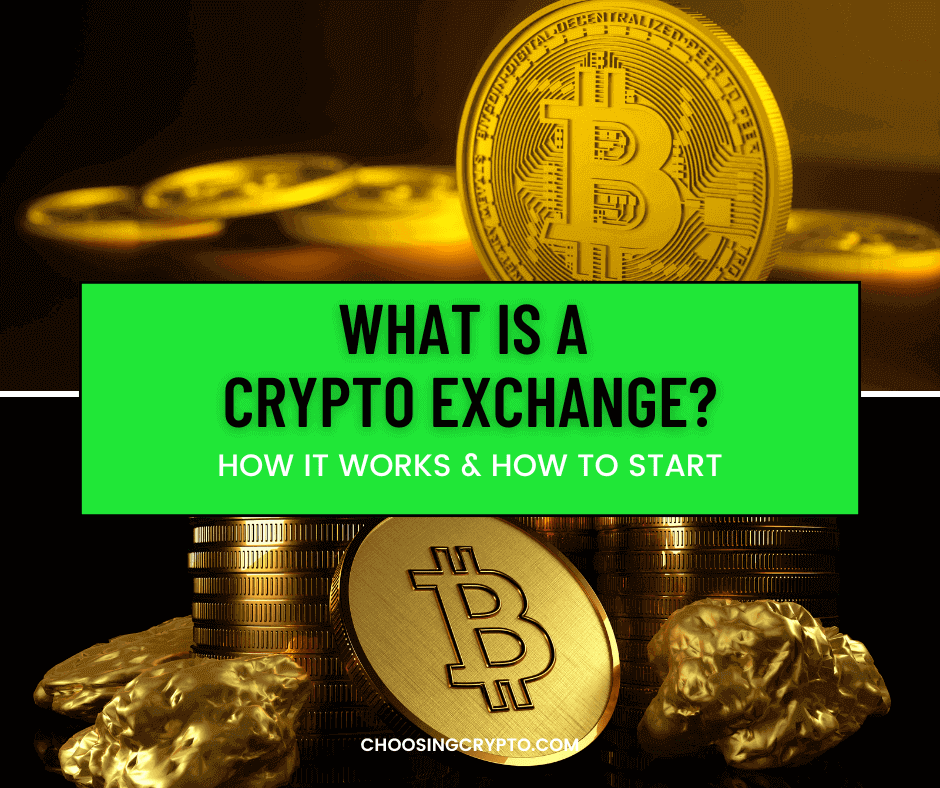Ever wondered what a crypto exchange is or how it works? You’re not alone. With all the talk of scams, lost funds, and complicated platforms, it’s easy to feel overwhelmed before getting started.
But here’s the thing—trading crypto doesn’t have to be confusing. And if you know what to watch out for, you can avoid common mistakes and protect your money.
If you’re serious about making money with cryptocurrency, understanding exchanges isn’t just helpful—it’s essential. Without the right knowledge, you could lose money to hidden fees, bad decisions, or even scams before you get a chance to profit.
The good news? It’s simpler than you think. Once you understand how exchanges work and what to avoid, you can trade confidently and keep your investments safe.
This guide will show you exactly what a crypto exchange is, how it works, and how to get started the right way—without unnecessary risks.
What Is a Crypto Exchange?
A crypto exchange is an online platform where you can buy, sell, trade, and store digital assets like Bitcoin and Ethereum. Think of it as a marketplace where you can swap one cryptocurrency for another or convert crypto into regular money like USD, EUR, or GBP.
Before crypto exchanges existed, getting cryptocurrency was complicated. You had to mine it, collect tiny amounts from faucets, or find someone willing to sell. Buying Bitcoin meant finding someone willing to sell, negotiating a price, and handling the trade manually—often through online forums like BitcoinTalk.
It was slow, risky, and unregulated. If a seller disappeared with your money, there was little you could do to get it back.
Crypto exchanges changed everything. Now, buying and selling is as easy as placing an order. The platform finds a match and completes the trade for you automatically. Many exchanges also offer advanced tools like margin trading, futures, and staking, making them useful for both beginners and experienced traders.
Knowing how exchanges work helps you make smart choices and trade with confidence in the crypto world.
How Does a Crypto Exchange Work?
To understand how a crypto exchange functions, think of it like a mix between a bank and a stock market—built specifically for digital currencies. It connects buyers and sellers, processes trades, and keeps funds secure. Here’s how it all works:
1. Matching Buyers and Sellers (Order Matching)
Every trade needs two people: a buyer and a seller. Instead of negotiating directly, they place orders on the exchange.
- A buyer says, “I want to buy 1 Bitcoin for $50,000.”
- A seller says, “I want to sell 1 Bitcoin for $50,000.”
- If prices match, the exchange completes the trade automatically.
If there’s no match, the order stays in the exchange’s order book—a list of all open buy and sell requests—until someone else is willing to trade at that price.
2. How Trades Are Processed
When placing an order, you can choose:
- Market Order: Buy or sell instantly at the best available price.
- Limit Order: Set a price, and the trade only happens if the market reaches it.
Market orders are fast. Limit orders give you more control.
3. Why Liquidity Matters
For seamless trading, a good exchange needs liquidity—a steady flow of buyers and sellers—so trades happen quickly.
Market makers help with this by placing large buy and sell orders, keeping prices stable.
4. How the Exchange Manages Your Funds
When you deposit money or crypto, it goes into the exchange’s managed wallet, not your personal one. This setup makes trading faster and more secure.
After a trade, your balance updates instantly, but your crypto stays in the exchange’s shared storage until you withdraw it to your own wallet.
This structure allows for fast trading but also means that until you withdraw your funds, the exchange retains control over them.
Don’t Miss: Important Security Features to Look for in a Crypto Exchange
Types of Crypto Exchanges
Crypto exchanges work differently, and they usually fall into three types: Centralized Exchanges (CEXs), Decentralized Exchanges (DEXs), and Hybrid Exchanges. Each has its own strengths and weaknesses. Let’s break them down.
1. Centralized Exchanges (CEXs) – The Most Popular Choice
A Centralized Exchange (CEX) is managed by a company that handles transactions, stores user funds, and provides security—similar to how a bank works for crypto trading. These platforms are easy to use and packed with features, making them the go-to choice for beginners.
Pros of CEXs:
- Easy to use, even for beginners
- High liquidity—fast trades with plenty of buyers and sellers
- Advanced trading tools like margin trading, staking, and futures
- Allows fiat-to-crypto purchases—buy crypto with your bank card or transfer
Cons of CEXs:
- Requires KYC verification—ID verification for security
- The exchange holds your funds, meaning you don’t fully control them
- If the exchange is hacked, your funds could be at risk
Popular CEXs: Binance, Bybit, Gate.io
2. Decentralized Exchanges (DEXs) – Full Control, No Middlemen
A Decentralized Exchange (DEX) allows direct, peer-to-peer trading without a central authority. Instead, smart contracts handle transactions, giving you full control of your cryptocurrencies.
Pros of DEXs:
- No KYC verification—trade anonymously
- Full control over funds—no centralized entity holding assets
- Lower risk of hacking—funds remain in users’ wallets, not on the exchange
Cons of DEXs:
- Lower liquidity—fewer buyers and sellers can result in slower trades
- More complex for beginners—requires using external wallets
- Fewer features
Popular DEXs: Uniswap, PancakeSwap
3. Hybrid Exchanges – A Combination of CEX and DEX Features
Hybrid Exchanges combine the convenience of CEXs with the security of DEXs. They let you trade quickly while keeping control of your private keys. However, they’re still new and not as common as other exchanges.
Pros of Hybrid Exchanges:
- More secure than CEXs—users retain control over their funds
- Easier to use than DEXs—offering a balance between convenience and autonomy
Cons of Hybrid Exchanges:
- Still in early development—many platforms are relatively new and not widely used
- Fewer options available—there are not as many hybrid exchanges compared to CEXs and DEXs
How to Start on a Crypto Exchange
Getting into crypto may seem complicated at first, but breaking it down into steps makes the process much easier. Whether you’re buying your first Bitcoin or trading regularly, following the right approach helps you avoid mistakes, stay secure, and trade with confidence.
Step 1: Choose a Reliable Exchange
Not all exchanges are safe or beginner-friendly. Some have high fees, weak security, or are outright scams disguised as real platforms. It’s important to pick a platform with strong security, fair fees, an easy-to-use interface, and a solid reputation. Researching user reviews and security features will help you find a trustworthy exchange, but popular crypto exchanges that are beginner-friendly include Binance, Bybit, and Gate.io.
Step 2: Sign Up and Verify Your Identity (KYC)
Once you’ve chosen an exchange, create an account by visiting the official website, clicking “Sign Up,” entering your email, and setting a strong password. Most centralized exchanges require identity verification before allowing deposits or withdrawals. This process, known as Know Your Customer (KYC), involves submitting a government-issued ID and completing a live selfie or video verification. Approval times vary, ranging from a few minutes to several hours.
Step 3: Deposit Funds (Crypto or Fiat)
Before trading, you need to fund your account. Most exchanges support multiple deposit options, including bank transfers, credit or debit cards, peer-to-peer transactions, and direct crypto deposits from an external wallet. Choose the method that best suits you.
Step 4: Start Trading (Beginner Tips)
With funds in your account, you’re ready to trade. If you’re new to crypto, start with small amounts to understand how the market moves. The crypto market is unpredictable, so only invest what you can afford to lose. Learning different trading strategies, following market trends, and using tools like limit orders can help you make smarter decisions.
Step 5: Withdraw Securely
When you’re ready to cash out or move funds off the exchange, you have several options. You can transfer your crypto to an external wallet for better security, withdraw to your bank account by converting crypto to fiat, or use a crypto debit card to spend directly at stores or withdraw cash from ATMs.
Additional Resources:
- How to Open a Crypto Exchange Account
- 5 Top Crypto Exchanges That’s Best for Beginners
- Common Mistakes to Avoid When Using Crypto Exchanges
- How to Choose the Right Crypto Exchange: Factors to Consider
- Pros and Cons of Different Crypto Storage Solutions
And guess what? We’re also on Instagram and Twitter(X). Join us there for even more fun and useful content!

DISCLAIMER:
The information provided here is for informational purposes only. Do not rely solely on it for making investment decisions. It is not financial, tax, legal, or accounting advice. Always do your own research or consult a financial advisor before investing in cryptocurrency.
